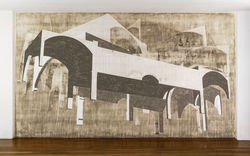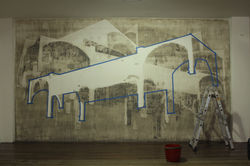 |  |  |  |  |
|---|---|---|---|---|
 |  |  |  |
NAVE
Estudio del artista
2013
Al dejar al descubierto el proceso mismo de la obra, el artista le asigna a ésta un valor adicional que va más allá del acabamiento, de la terminación y de su finalización. En este sentido, la obra de Franco estaría en resonancia, quizá, con la “Teoría de la formatividad”, enunciada por Luigi Pareyson, quien insistía en que la obra de arte tenía algo donde la forma continuaba componiéndose más allá de la decisión del artista; teoría que Umberto Eco aplicaría para su famosa “Obra abierta”. Al develar ese proceso el artista no hace sino insistir en dejar al descubierto el andamiaje de sus imágenes, que a su vez se enriquecen mostrando en el mismo instante el antes y el después. El espectador puede observar la obra en ejecución; hecho que se convierte en una experiencia artística fundamental, una “experiencia física” (Franco) que de una u otra manera se comparte con el espectador.
 |  |  |  |  |
|---|---|---|---|---|
 |  |  |
Esto es lo que sucede en la obra Nave (julio-octubre de 2013). En ella un fragmento de una construcción del siglo XVII (la nave central) se desdobla y vuelve a configurarse en su soporte. Esta obra se hace y se deshace en la pared, generando así nuevas imágenes, insistiendo, por un lado, en el paso ineludible del tiempo, y, por otro, creando una especie de arqueología de la imagen, donde memoria y actualidad se conjugan armoniosamente. El principio mismo de esta pintura es el des-ocultamiento, y se realiza en la pared con barro que el artista extrajo de Apulo (Cundinamarca). Las figuras arquitectónicas, se realizan en la pared, y luego se borran con ayuda del agua, dejando una huella que se amalgama con otras formas similares generando una imagen futurista que parece flotar en un espacio gracias al movimiento de las varias capas, pareciendo girar sobre sí misma. Como testimonio de este proceso que solo algunos pocos han podido ver, quedan fotografías y un video.
Ricardo Arcos-Palma
Video by iconsmind.com from the Noun Project
NAVE
Artist's studio
2013
In leaving the very process of the work exposed, the artist assigns his work this additional value that goes beyond completing, finishing or finalizing it. In this sense, the work by Franco would perhaps be in resonance with the "Theory of formativity," enunciated by Luigi Pareyson, who insisted that there was something intrinsic in the work of art that enables the form to continue being composed beyond the artist's decision; a theory that Umberto Eco applied to his famous Open Work. By revealing this process in that "brutalism," the artist merely insists on exposing the scaffolding of his images, which in turn are enriched by showing the before and after at the same time. This is where the video illustrates the artistic process. Viewers can observe the work in progress; a fact that becomes a fundamental artistic experience, a "physical experience" (Franco) that in one way or another is shared with the viewer.
This is what happened in the work Nave (Ship, July- October 2013). In it a fragment of a 17th Century building is unfolded and re-configured on the wall, This work is done and undone on a big wall in a process that generates new images that convey, on the one hand, the inevitable passage of time and, on the other, the creation of a kind of archeology of the image in which memory and the present come harmoniously together. The same principle of this painting is the un-concealment, and it takes place on the wall with mud that the artist picks in several parts of the country. Architectural drawings that somehow remind us of historic buildings are created on the wall and then erased with water, leaving a trace behind that amalgamates with other, creating a futuristic image that appears to float in the space thanks to the movement of this image that, created with several layers, seems to rotate over its own axis. Photographs and a video serve as testimony of this process that only a few have been able to see.
Ricardo Arcos-Palma


